Op-Ed
The Museum of Fine Arts, Houston Must End Its Head-in-the-Sand Approach to Justice When It Comes to Restitution
The head of the Monuments Men Foundation on the pain-staking research into the real history behind a Bellotto painting at the MFAH.
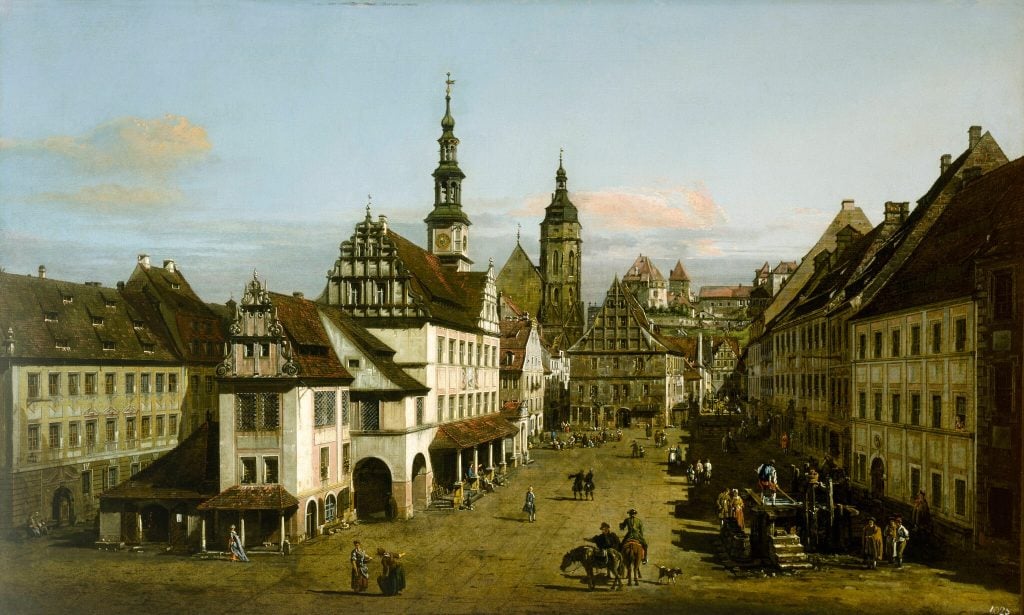
The head of the Monuments Men Foundation on the pain-staking research into the real history behind a Bellotto painting at the MFAH.

Robert Edsel

A New York Times article two weeks ago provided an excellent overview of the dispute between the heirs of Max Emden, a German Jew, and the Museum of Fine Arts, Houston over a painting by Bernardo Bellotto, Marketplace at Pirna, which Nazi leader Adolf Hitler acquired from Emden for his planned Führermuseum. The MFAH, which has displayed the painting for some seventy years, claims Emden voluntarily sold the painting in June 1938 for a fair price. The Emden heirs believe that the transaction was a direct consequence of economic hardship caused by Nazi persecution. The Federal Republic of Germany concurred with them in 2019 when it restituted to the Emdens the other Bellotto paintings that were part of a three-painting sale.
The Monuments Men Foundation for the Preservation of Art, guardian of the legacy of the men and women who located and returned millions of works of art and other cultural objects stolen by the Nazis during World War II, sides with the Emden heirs. Gary Tinterow, director of the Houston museum, certainly has a fiduciary obligation to protect the assets of the museum from spurious claims, but he has an even greater duty to preserve the museum’s reputation, a priceless asset that belongs to the citizens of Houston. Moreover, using obfuscation and legal technicalities to retain possession of a painting that cost the museum nothing—it was a gift from the foundation of noted philanthropist and collector, Samuel Kress—is entirely inconsistent with the “just and fair solutions” envisioned in the Washington Principles on Nazi-Confiscated Art, and the intentions of Congress in passing the HEAR Act in 2016.
In the course of our initial efforts to meet with the MFAH to discuss the foundation’s research discoveries, we received a May 24, 2021 email from Mr. Tinterow informing us that Houston’s ownership of the Bellotto painting had been “thoroughly examined by the museum and our independent provenance researcher, Laurie Stein,” referring to a 2007 report on the wartime history of the Bellotto.
Ms. Stein is an accomplished professional who has worked in this specific field for many years. Nevertheless, the nearly fifteen-year-old report that she prepared is both flawed and dated. Reading it today, with our current knowledge, leaves the impression that her work began with a predetermined outcome. One also cannot help but wonder: If Ms. Stein possessed all the information recently unearthed by the Monuments Men foundation, and took into account the 2019 decision by the Federal Republic of Germany to restitute to the Emdens the other Bellotto paintings that were part of the three-painting sale, would she come to a very different conclusion? (To read the full Stein Report, including the foundation’s detailed analysis, click here.)
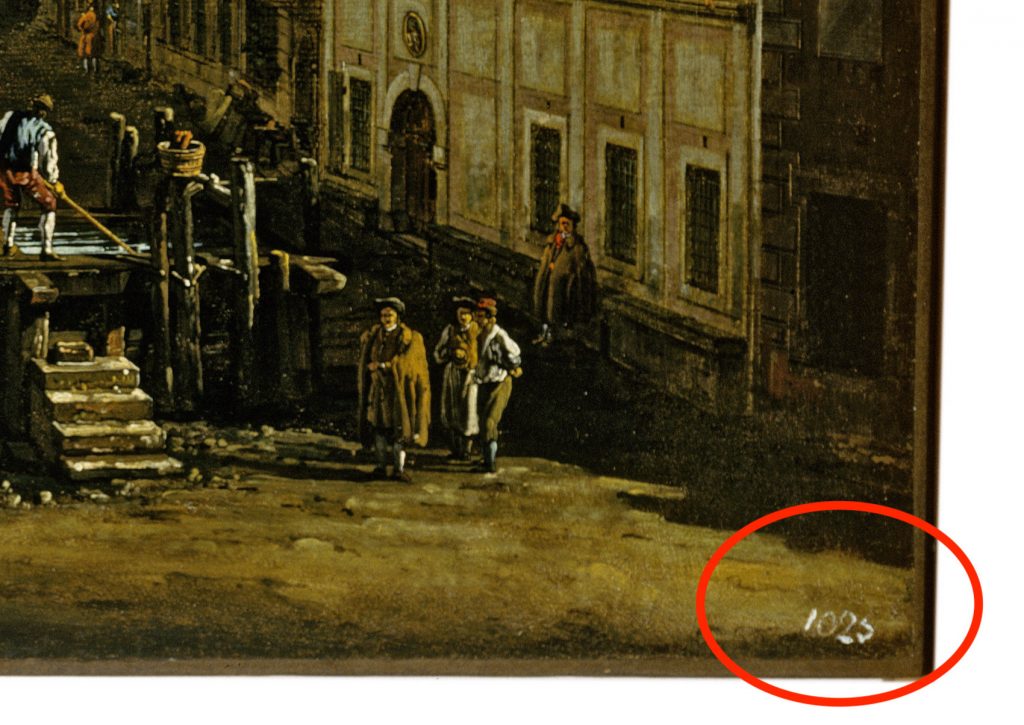
An inventory number from Gottfried Winckler can be seen on the corner of Bernardo Bellotto’s The Marketplace at Pirna (ca. 1764). Collection of the Museum of Fine Arts, Houston. This number can be seen faintly in historic photographs of the work, proving this is the same version of the work sold by Max Emden.
The basics of provenance research begin with a visual examination of a work of art looking for any unique clue that might help researchers clarify the history of the painting and its previous ownership. How, then, is it possible that such an accomplished provenance researcher failed to take note of a collector inventory number—1025—prominently displayed on the front of the MFAH’s Bellotto painting?
Even more alarming, how do two museum directors and numerous curators fail to notice such a glaring omission? Where is the intellectual curiosity at a museum with “nearly unparalleled resources,” to quote Gary Tinterow, or did they not want to know?
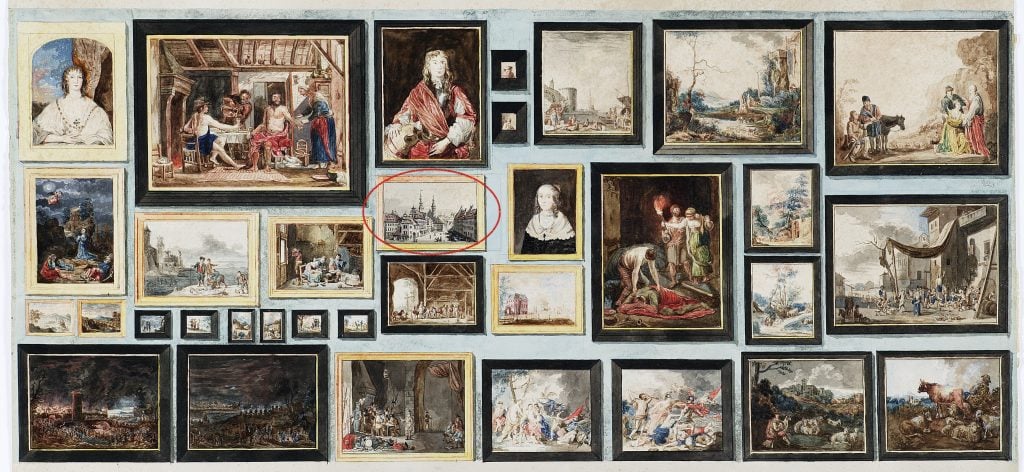
This watercolor of the Gottfried Winckler Collection in Leipzig shows Bernardo Bellotto’s The Marketplace at Pirna (ca. 1764), which later belonged to Max Emden. Courtesy of the Stadtgeschichtliches Museum Leipzig, via the Monuments Men Foundation.
Great collectors in the 18th century often had inventory numbers painted onto works of art in their collections. Like a fingerprint, the 1025 inventory number proved to be the key piece of evidence that we believe confirms that the painting in Houston is the same one owned by Max Emden. In a short period of time, the Monuments Men Foundation not only identified the collection the painting came from (Gottfried Winckler Collection; Leipzig), but more importantly, located two photographs—one taken in 1930 by Anna Caspari, the dealer who sold the painting to Emden, and the other taken in 1938 by Hitler’s art dealer, Karl Haberstock, after he purchased the painting from Emden for Adolf Hitler. The inventory number is visible in both photographs. These images, at the Witt Library in London, and the Haberstock Archives-Augsburg, would have been accessible in 2007.
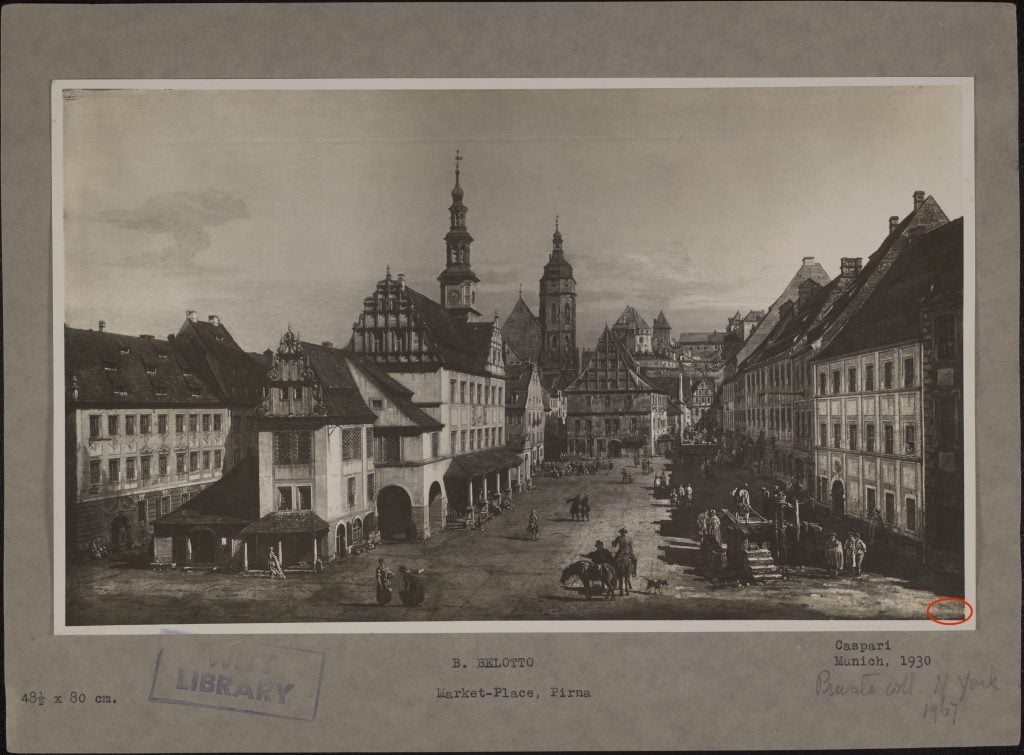
This photograph of Bernardo Bellotto’s The Marketplace at Pirna (ca. 1764) taken by art dealer Anna Caspari before she sold it to Max Emden shows a faint inventory number in the corner from former owner Gottfried Winckler Photo from the Witt Library in London, courtesy of the Monuments Men Foundation.
This identification is not about being fussy. The fact that there is confusion over which version of this painting is in the MFAH collection has long been among the museum’s talking points. In her 2007 report, Ms. Stein notes that the “identity of the object itself is in question…” before making a remarkable statement: “Regardless of the fact that MFAH’s Bellotto may not be Emden’s Bellotto, MFAH’s Bellotto has a provenance that is clear of any adverse title claim related to the Third Reich.” How can anyone acknowledge uncertainty about which version of a painting they own—and therefore a lack of knowledge about who the prior owners were—and then state with certainty that it has not been tainted by Nazi ownership?
The museum’s approach to this whole matter has been confused. Despite Ms. Stein’s doubt that the Houston painting was Emden’s Bellotto, the museum subsequently chose to insert Emden’s name into the provenance. However, earlier this year, just weeks after being contacted by the Monuments Men Foundation, the museum removed Emden’s name from the provenance altogether. “It was not meant to deceive,” Tinterow told the Times, explaining that he wanted the provenance to include “only what we know to be absolutely true,” adding that taking such action was “due to my frustration with a garbled provenance that needed to be sorted out.” In making this statement, Tinterow appears to be confirming the shortcomings of the Stein report, not defending it.
Ms. Stein’s report contains other statements, presented as facts, that are incorrect or unproven. For example, contrary to her inference, there is no evidence that Emden received payment from Haberstock. The 2019 German Advisory Commission addressed this issue, confirming that “there is no corresponding account note in the files” confirming receipt of payment by Emden’s bank in Switzerland.
More importantly, while it is true that Bellotto painted multiple versions of this subject, only one—the Emden version—has the 1025 collector inventory number. The “multiple versions” referenced in Ms. Stein’s report are a tired and convenient excuse that the museum has repeated for decades rather than doing the necessary research to separate and identify each version, a straightforward task for a museum with such vast resources and talented curators.
Another error in the report casts doubt on the bedrock of the MFAH’s defense. Stein states that Hitler’s art agent bought two different versions of Marketplace at Pirna. This claim serves to augment the suggestion that the painting’s background is hard to know—but that is simply not true.
Haberstock purchased the Bellotto Marketplace at Pirna from Emden in 1938, and a Bellotto Hauptstrasse von Pirna from British dealer Arthur Tooth in 1939. These are two different paintings; two different titles; two different scenes. Despite what the Stein report states, the provenance of the 1939 purchase is very clear. Today, the painting, Hauptstrasse von Pirna, carries the title View of Pirna with the Fortress of Sonnenstein, and hangs at the Art Institute in Chicago. That painting did not pass through the Munich Central Collecting Point, the depot established by the Monuments Men to process stolen works of art. Instead, the Monuments Men processed it through the Wiesbaden Collecting Point because they deemed it German-owned property. The painting was eventually returned to Haberstock after the war. He sold it to a private collector who in turn sold it to a later owner, who at last sold it to the Art Institute.
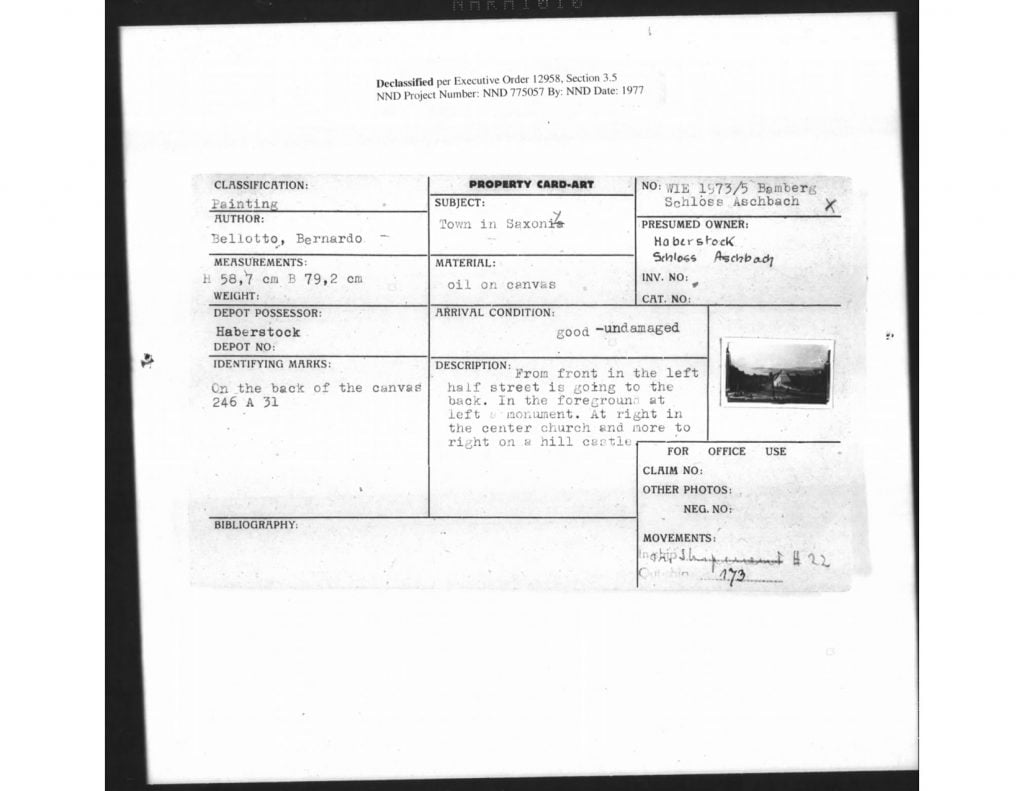
The Wiesbaden Central Collecting Point property card for Bernardo Bellotto’s View of Pirna with the Fortress of Sonnenstein. Image courtesy Monuments Men Foundation.
We now know that the Monuments Men sent Emden’s Bellotto to the Netherlands in 1946 believing, in error, that it was the version of a painting being sought by Dutch officials. In May 1949, when Monuments Man Stefan Munsing, director of the Munich Central Collecting Point, realized the mistake had been made, he wrote his counterparts in the Netherlands explaining how the error occurred, and asked for Emden’s Bellotto to be returned to Munich. By that time, however, the Dutch had restituted Emden’s painting to Mr. Hugo Moser, a German art dealer living in New York City. We find it stunning that Ms. Stein chose not to include any reference to this error in her report, and even more baffling that she didn’t include a copy of Munsing’s letter requesting that the Emden painting be returned.
Concerning the restitution to Moser, Ms. Stein notes in her report that she “located a file in the Dutch restitution records that should be consulted to provide clarification.” The question remains: Why wasn’t that lead pursued, especially when the museum knew that Samuel Kress, donor of the Bellotto painting to Houston, had purchased it from Moser? By contrast, the Monuments Men Foundation did pursue the Dutch lead, months before even having access to the Stein report, which helped us unravel an ancillary but significant part of the case.
We agree with Ms. Stein when she says it is “curious” that the two Bellotto paintings restituted to the Emden heirs in 2019 by the German government still have Linz (Führermuseum) and Munich Central Collecting Point numbers while the Houston painting has neither. Those labels/markings were certainly present when the painting left Munich. Who removed them, and why? It’s a short list of suspects, but we believe the evidence implicates Hugo Moser.
According to Dutch records, Moser purchased his distinct version of Bellotto’s Marketplace at Pirna in 1928 at Lepke’s auction house in Berlin. But in 1952, when Moser offered to sell “his” restituted painting to the Kress Foundation, he made no mention of his 1928 purchase. In fact, the foundation believes the provenance he presented to Kress was completely fabricated, designed to hide the fact that Dutch officials had, in error, returned Emden’s Bellotto to him, not the painting he purchased in 1928. Knowing that the presence of a Hitler/Linz (Führermuseum) label and Munich Central Collecting Point number would reveal the truth, we believe Moser removed all telltale details. He then used his skills and knowledge as an art dealer to create an entirely new and fictitious provenance cleverly designed to avoid scrutiny—and it worked. The Kress Foundation purchased the painting under fraudulent circumstances, and in 1961, donated the painting that belonged to Max Emden to the MFAH.
Seventy years passed before someone bothered to verify the provenance Moser provided to Kress. It wasn’t Kress; it wasn’t the MFAH; and it wasn’t Laurie Stein. It was the Monuments Men Foundation for the Preservation of Art.
Today, the museum continues to justify its ownership of the Bellotto by relying on the 2007 “voluntary sale by Emden” argument. This “head in the sand” position ignores the 2019 ruling of the German Advisory Commission—a panel of accomplished jurists and scholars formed to evaluate cases involving loss of assets through persecution—that Emden’s three-painting sale to Karl Haberstock was not voluntary:
There is no question that the sale of the aforementioned three paintings by Bernardo Bellotto to Karl Haberstock in the early summer of 1938 did not take place of his own free will, but was quite directly caused by the resulting economic hardship…the core fact remains that Max Emden’s economic plight was directly triggered by the National Socialist persecution and the resulting loss of assets due to the persecution.
Even if the museum’s argument prevailed—that Emden voluntarily sold all three paintings to Haberstock, then the rightful owner would have been Adolf Hitler and the Reichschancellery. As successor to property owned by Hitler, the painting would then pass to the Federal Republic of Germany, as happened with Emden’s other two Bellottos, who would then return the painting to Emden, just as they did the other two. It’s a binary outcome. Either way, “Houston, you have a problem.”
Robert M. Edsel is the Founder and Chairman of the Monuments Men Foundation for the Preservation of Art.